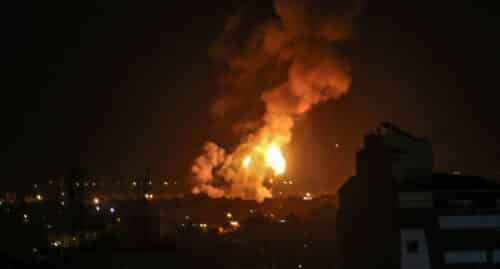The State of Israel suffered an unprecedented blow. Over 1,000 casualties, both soldiers and civilians; the elderly, children and toddlers who were brutally slaughtered in their homes, atrocities which make ISIS’ carnage seem insignificant and many, many hostages. Beyond the grief and the rage sweeping the nation, the same thought is running through all our minds – how did this happen to us? After the initial shock, one equally important question began to emerge – what now?
The Puzzle Israel was Unable to Solve
Imagine you had to put together a puzzle with numerous pieces, without knowing what the image you were meant to create looked like. You also don’t know exactly how many pieces the puzzle has, or even if you have them all – the pieces can be put together in more than one way. This is the task of army intelligence. In order to compose an intelligence image, as many pieces as possible must be gathered, and then put together clearly, with a number of possible pictures emerging. From what’s been made public thus far, it appears that Israeli intelligence in Gaza, the responsibility of both the IDF and the general security services, was a failure on both stages of putting the puzzle together; both in gathering the pieces and in linking them to one another.
Why were we missing pieces? One of the laws of physics in wartime is the law of pendulum. Each time one side inserts a new ability in the sphere, the other side studies it and undertakes strategic and tactical changes against it. Examples known to many of us are the Six Day War and the Yom Kippur War. In the Six Day War the Israeli Air Force shifted the pendulum to one side, as their pre-emptive air strike determined the war’s outcome right at the start. In the Yom Kippur War, the pendulum’s counter-swing occurred as the enemy learned the method and armed themselves with anti-aircraft missile which prevented the Air Force from functioning effectively.
Additionally, during various altercations with the Hamas, the enemy identified the IDF’s pattern of action. This pattern is based on specific intelligence abilities on the one hand, and on an absolute air advantage held by the Israeli Air Force on the other. With a swing of the pendulum, Hamas altered its behaviour on two fronts: First, they constructed an underground system which allowed them to function even as they were undergoing significant attacks from the air. Secondly, they adapted the manner in which they acted vis-à-vis their field intelligence, in a way which touched on Israeli intelligence’s hidden weaknesses.
The Missing Pieces of the Puzzle: Where is the Human Intelligence?
What exactly was that weak spot? Reliance upon a specific type of intelligence, while ignoring other types. In recent years, the Israeli intelligence community based its work on one sort of intelligence gathering – technological intelligence. Israel’s cyber capabilities became more sophisticated over time, which led to a deficit in their “traditional” gathering abilities, based on HUMINT, or in other words, human intelligence. It’s obvious at the higher reaches of the agencies; the top levels of the Mossad or the Security Services are no longer headed up by field operatives with experience running agents; instead they’re techies. Hamas understood the IDF’s power in terms of its technology and they found a way to work around it.
Given that Hamas, even with their Iranian backing, don’t possess the technological means to break the tie, they chose an opposite track; they established a communications network which is not based on technological means and used it to manage secret information and war preparations. They made sure to employ a deceptive strategy, as though there were no war plans in the pipeline.
An effective HUMINT system could have prevented the subterfuge. At least 1,000 terrorists were involved in the first day of the Hamas operation, and if even one of them had made contact with Israeli intelligence in order to let us know what was about to happen, it would have been enough. Based on information publicized thus far, it appears that crucial pieces of the puzzle, which could have been discovered using human intelligence, were not in IDF hands. Without these pieces, it’s very difficult to put together the intelligence picture.
Confirmation Bias: The Return of the Conception
The lack of pieces doesn’t tell the entire story. It appears as though some of the information did reach some of the upper ranks of the IDF, whether technologically or otherwise.
This is where the analytical failure comes into play, hurling us back to the Yom Kippur War: the line of reasoning. This time as well, Israel was under the spell of the conception according to which there was an “equation that worked”. It seemed as thought the stick and carrot method which Israel used against Hamas was working. Israel believed that Hamas were truly interested overall in their own survival and benefits for their own people and less in seeking an all-encompassing war. Israel believed that the carrots of suitcases of money and sticks of occasional rounds of fighting were ensuring quiet and deterrence.
One of the hardest examples of bias in human thought is confirmation bias. This leads us to interpret facts and figures in a narrow manner which confirms our prior beliefs. For this reason, bit of the puzzle which reached us were put together based on an existing paradigm which claimed that Hamas wasn’t interested in escalation and “were deterred”. These pieces could have helped to create a more complete picture, if not for that bias.
In a book I published earlier this year, “No Turning Back”, I addressed the dangers in thinking about rounds of fighting in order to achieve peace: “The Israeli attempt demonstrated that any attempt to purchase long-term quiet without dealing with deterrence will, in the end, lead to a stronger, more powerful Hamas”. And that is precisely what happened. Not the rounds of fighting themselves, but rather the constant policy of deterrence, which is what allows the IDF to keep control, for example, in Jenin and prevent it from becoming the 2nd Gaza Strip. Restrained by the ropes of the Oslo Accord and the withdrawal from Gush Katif, the IDF’s possibilities to remain present on the ground in Gaza are now non-existent, unlike in Jenin. This is why Jenin doesn’t have a system of rocket launchers aimed at Israel, while Gaza does.
What Happens After the War? The Fate of Gaza is the Same as the Fate of Jenin
The Hamas must be eradicated. This is clear. What does this eradication involve and what is the scale according to which the victory should be considered? Not only destroying the organization’s current capabilities, but rather preventing any possibility of the organization rehabilitating itself in the future. In order to dismantle their rule once and for all and achieve this result, there is no choice but to engage in long, harsh fighting, including, in the end, a ground incursion and a deep cleaning of the area from all terrorists. Unconditional surrender is the least one can demand.
But, what about the day after? Even after the Hamas are eradicated, if we don’t learn to ensure the IDF’s freedom to act in the Gaza Strip, another terror organization is likely to emerge who will seek our annihilation. In order to achieve true peace and quiet in the region, we must be able to act in the Gaza Strip in normal times as well. Just as the IDF destroyed the terror infrastructures in Jenin in Operation Defensive Wall, yet continue to go in, in order to prevent terrorist attacks, and to continue destroying terror infrastructures, we must ensure that the IDF are given free reign to act in the Gaza Strip.
The aim of the current operation is first to bring Gaza to an opening point in which it is free of terror. Once this happens, we must guarantee ourselves the option to keep it free of that terror.
I want to send my strongest support to our fighters, for them to succeed in their mission.






